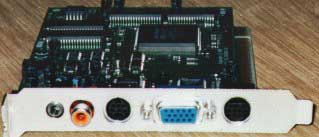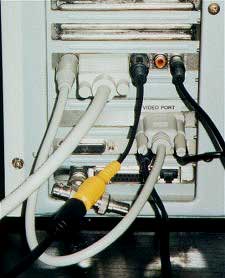|
|
|
|
|
REALmagic Hollywood Plus DVD Decoder Card |
|
Join the community - in the OCAU Forums!
|
Setting Up The System
System Requirements:
The beauty of the Hollywood Plus is that the system requirements are not very taxing at all. You need:- Pentium 133MHz or higher (AMD or Cyrix Equivalent CPU)
- PCI 2.1 compliant expansion slot
- Plug and Play BIOS support
- 16MB RAM and 2MB free hard disk space
- SVGA card
- DVD-ROM drive
- Windows 95/98/NT4
- Bus mastering IDE controller recommended
- Amplified stereo speakers (Dolby AC-3 or Dolby Pro-Logic amplifier and speakers required for surround sound)
As the hardware requirement of the Hollywood Plus is so minimal, I decided to drag my old Pentium 166 MMX out of the cupboard, and set it up as a dedicated A/V PC. That way I can use the PC for DVD's and MP3's as well as standard audio CD's. With the ability to squeeze more than 10 hours of MP3's on to a single CD-ROM, the machine can run effectively as a big CD-Stacker/Jukebox when it's not being used as a DVD player. This frees up my main machine, and means that I can keep the A/V PC inside my entertainment cabinet, close to all the A/V gear, whilst my main PC can go back to its little spot in the study. Note that the Hollywood Plus will not decode MP3 files - your CPU must be fast enough to software decode MP3's (using Winamp or similar) - a Pentium 133 should suffice but it may depend on the MP3 application you use.
Using a few pre-loved components, you can put together a basic A/V PC for less than the cost of a good quality stand-alone DVD player, and you get to use it for CD's and MP3's too.
Installation:
Installation of the Hollywood Plus is a breeze. Simply insert the Hollywood Plus into a spare PCI slot, install the driver and the DVD player application "DVD Station", connect your A/V equipment, grab a bag of chips, top up your coke, and sit back to enjoy!
It really is that easy, though the flexibility of the Hollywood Plus gives you a few options when it comes to connecting your A/V equipment. Here is a shot of the back of the card.

I/O connectors are (from left to right) Audio Out (3.5mm), S/P-DIF Out, S-Video Out, VGA Out, and VGA In. There are also a Line-out and Cd-in connector on the top edge of the board, which may be used to internally interface your sound card in place of the external audio connector, or to interface the cd-rom to the Hollywood plus if you choose not to install a sound card in the machine.
If you are lucky enough to own a Dolby Digital amplifier/receiver, you can connect it via the S/P-DIF connector on the Hollywood Plus. This allows you to get the full effect of the 6 discrete digital sound channels that most DVD titles are recorded with (Front Left, Front Centre, Front Right, Rear Left, Rear Right, LFE (Low Frequency Effects or sub-woofer).
If you don't have a Dolby Digital amp, have no fear. You can still connect your amp (either standard stereo or Dolby Pro-Logic) via the 3.5mm stereo output connector on the Hollywood Plus card. The supplied 3.5mm stereo loop cable also allows you to loop the audio output of the Hollywood Plus into your sound card, from which you attach your amplifier to the line-out connector. This allows you to also play standard audio cd-rom software and MP3's through your amplifier.
On the video side of things, the Hollywood Plus allows you to play back decoded video to your monitor or directly out to your television either as a composite or as S-video signal. For output to television, S-Video is preferred as it generally provides a higher quality image. However, your television or A/V amplifier must have an S-video input to make use of this. As my own TV is an older model that doesn't have the S-Video input, I used the supplied S-Video to composite adaptor cable and found the image quality to be excellent regardless.
To enable you to watch decoded DVD's on your monitor, you connect the output of your standard video card to the VGA-In connector of the Hollywood Plus (using the supplied video loop cable), and attach your monitor to the VGA output connector on the Hollywood Plus. Its then up to the powerful EM-9010 video overlay controller on the Hollywood plus to display the image on your monitor. It should be noted that you can't simultaneously watch a movie on both the monitor and television.
Confused? My own set up is shown below.

I connected the sound output from the Hollywood Plus into my sound card (using the loop cable), then from the sound card out to my amp. As I don't have a Dolby Digital amp, the S/P-DIF connector went unused. I ran the video loop cable from my video card into the Hollywood Plus, and connected the computer monitor to the VGA-Out on the Hollywood Plus. Using the S-video to composite cable, I connected the Hollywood Plus to my VCR. I connected it to the VCR rather than directly to my TV because my television has only one video input (which is used by the VCR anyway). Otherwise I would have had to disconnect the VCR from the TV so that I could plug in the Hollywood Plus. By using the video input of the VCR, I get around this problem, and on to another little problem called Macrovision.
It is mandatory for a DVD decoder card manufacturer to build an analog copy protection circuit into the output of the card to prevent analog copies of a DVD. This circuit is called Macrovision and is triggered by signals encoded on the DVD. Typically, Macrovision adds pulses in the vertical-blanking signal to the composite video and s-video outputs, and may also add a rapidly modulated colour-burst signal. This confuses the synchronisation and automatic-recording-level circuitry in 95% of VCR's.
Macrovision may show up as stripes of colour, distortion, rolling, black & white picture, or dark/light cycling. The whole idea is to stop you making a legible analog copy of the movie via the VCR, and would normally force you to connect the DVD decoder output directly into the TV video input. Fortunately, thanks to a couple of brilliant little shareware/freeware utilities, we can disable Macrovision on the Hollywood Plus - I will talk more about these utilities later in this article.
|
|
Advertisement:
All original content copyright James Rolfe.
All rights reserved. No reproduction allowed without written permission.
Interested in advertising on OCAU? Contact us for info.
|

|


